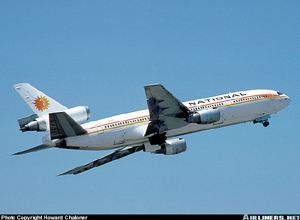Passengers 116 Fatalities 1 Date 3 November 1973 Summary Turbine engine failure Operator National Airlines | Crew 12 Survivors 127 Number of deaths 1 Injuries (nonfatal) 24 | |
 | ||
Similar EgyptAir Flight 741, Balkan Bulgarian Airlines Fl, JAT Airways Flight 769, Aeroflot Flight 141, Kano air disaster | ||
On November 3, 1973, a National Airlines DC-10-10 aircraft (N60NA) was operating as a scheduled passenger flight between Miami and San Francisco with intermediate stops at New Orleans, Houston, and Las Vegas (NA Flight 27).
At about 4:40 p.m., while the aircraft was cruising at 39,000 feet (12,000 m) 65 miles southwest of Albuquerque, the No. 3 (starboard) engine fan assembly disintegrated in an uncontained failure. Its fragments penetrated the fuselage, the Nos. 1 and 2 engine nacelles, and the right wing area. The resultant damage caused decompression of the aircraft cabin and the loss of certain electrical and hydraulic systems.
The flight crew initiated an emergency descent, and the aircraft was landed safely at Albuquerque International Sunport 19 minutes after the engine failed. 115 passengers and 12 crewmembers exited the aircraft by using the evacuation slides. As a result of the accident, one passenger died and 24 people were treated for smoke inhalation, ear problems, and minor abrasions. The plane was repaired and was later flown by Pan Am (as Clipper Meteor)
One passenger, G.F. Gardner of Beaumont, Texas, was partially forced into the opening made by a failed cabin window, after it too was struck by engine fragments. He was temporarily retained in that position by his seatbelt. "Efforts to pull the passenger back into the airplane by another passenger were unsuccessful, and the occupant of seat 17H was forced entirely through the cabin window." The New Mexico State Police and local organizations searched extensively for the missing passenger. A computer analysis was made of the possible falling trajectories, which narrowed the search pattern. However, the search effort was unsuccessful, and the body of the passenger was not recovered until two years later, when a construction crew working on the tracks for the Very Large Array radio telescope came upon his skeletal remains.
Investigation
The National Transportation Safety Board determined the probable cause of this accident was the disintegration of the No. 3 engine fan assembly as a result of an interaction between the fan blade tips and the fan case. According to the NTSB, "the precise reason or reasons for the acceleration and the onset of the destructive vibration could not be determined conclusively," but enough was learned to prevent the occurrence of similar events. The speed of the engine at the time of the accident caused a resonance wave to occur in the fan assembly when the tips of the fan blades began to make contact with the surrounding shroud. The engine was designed to have a rearward blade retaining force of 18,000 pounds to prevent the blades from moving forward in their mountings slots and subsequently departing the fan disk. The rearward force was not enough. As a result of this accident, GE re-designed the engine so that the blade retaining capability was increased to 60,000 pounds, and that change was incorporated into all engines already in service.
The NTSB expressed concern about the cockpit crew conducting an unauthorized experiment on the auto-throttle system. They had been wondering where the system took its engine power readings from and to see if it was the N1 tachometer readout "the flight engineer pulled the three N1 tachometer [circuit breakers]" and then adjusted the autothrottle setting. The cockpit voice recorder proved that the engines altered their power setting when requested, proving to the crew that the system was powered from another source. The crew then manually reset the throttles to the normal cruising power before the flight engineer had closed the tachometer circuit breakers. It was considered whether the crew had accidentally over-speeded the engine when setting power without the tachometers but there was insufficient evidence to deliver a certain verdict. Nonetheless; "Regardless of the cause of the high fan speed at the time of the fan failure, the Safety Board is concerned that the flightcrew was, in effect, performing an untested failure analysis on this system. This type of experimentation, without the benefit of training or specific guidelines, should never be performed during passenger flight operations."
